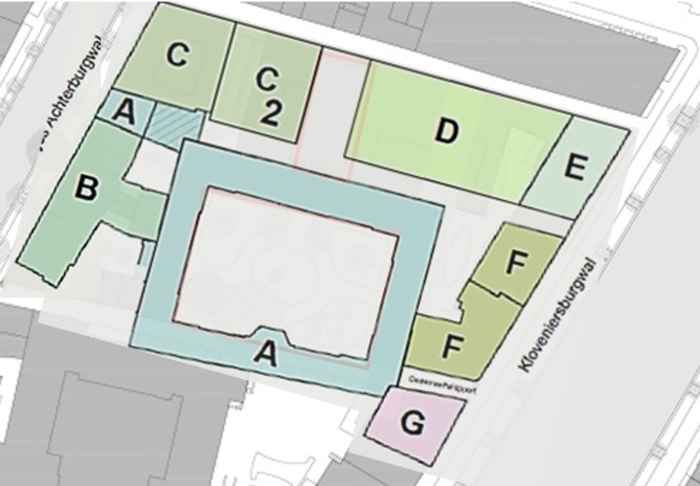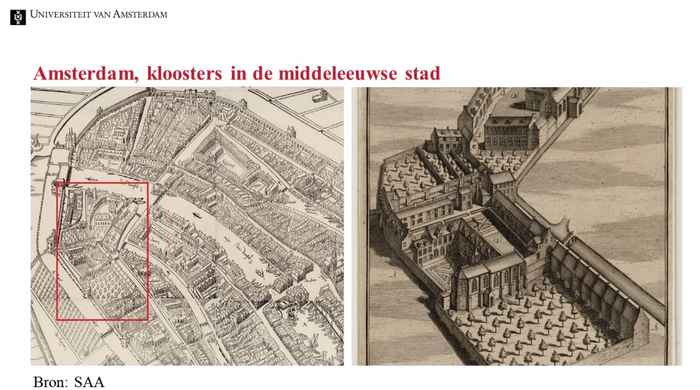Oudemanhuispoort
-
Our ambition

the building sections of the Oudemanhuispoort With the phased approach outlined below, the UvA aims to preserve the Oudemanhuispoort for the next ten to fifteen years for research and education for the rapidly growing student population. This allows the UvA time to explore the requirements and desires of both the UvA and the municipality for the future. The expectation is that this phased approach will make the (financial) risks more manageable.
Phase 1: Refurbishment of the square and buildings on Slijkstaat
The UvA will take the necessary measures in the square (A) and the buildings (C and D) on Slijkstraat. Education takes place here, and there are offices. This will remain unchanged. There will be no changes to the layout. The outdated seating, installations, and ICT will be replaced and made more user-friendly.
The interior will be addressed and refreshed, outdated installations replaced, and cabling for data traffic will be installed for better wifi and faster internet. Where it is logical and sensible, sustainability measures will be implemented. These are measures that align with good ownership of the building. These measures cause minimal disruption and will take place during educational periods. Disruptive activities will be carried out in the summer of 2025.
Phase 2: Renovation, Restoration, and Sustainability of Buildings on Kloveniersburgwal and Oudezijds Achterburgwal
In the monumental buildings on Kloveniersburgwal (E, F, and G), there is education, and in the section on Oudezijds Achterburgwal (B), there are mainly offices with support functions for education. After sustainability measures, the UvA will connect these buildings to the WKO system of the University Quarter.
Phase 3: Renovation, Restoration, and Sustainability of the Square and Buildings on Slijkstraat
The goal is to restore and renovate the buildings along Slijkstraat (C and D) and the square (A) in such a way that they meet current requirements for education and offices while making the historical values of the Oudemanhuispoort more visible and experiential. The OMHP will be an important link in the logistics of the University Quarter in the future, including supply and waste streams.
-
Timeline
Phase 1:
- The Final Design (FD) will be finished in Q4 2024.
- The tender phase for a contractor will be from Q3 2024 - Q1 2025.
- The phased construction of the square (A) and the buildings (C en D) at the Slijkstraat will be from Q3 2025 - Q3 2027.
- The building inauguration will be carried out phased in between Q1 2026 and Q4 2027.
- The building remains in use during the building activities.
Phase 2:
- The UvA will initiate the preparation of the design process for the buildings on Kloveniersburgwal and Oudezijds Achterburgwal in 2024 and anticipates starting the design process itself in 2025 and ending in Q4 2026.
- The tender phase will be from Q3 2026 from Q1 2027.
- The construction will be from Q2 2027 from Q3 2028.
- The building inauguration will be Q3 and Q4 2028.
- The buildings of phase 2 will be ready to use in Q1 2029.
Phase 3:
The restoration/renovation of building sections A (square) and C and D (along Slijkstraat) is postponed to 2035. This provides time to adjust plans as needed based on developments.
This shift in time means that the sustainability ambitions of the UvA for these buildings, as well as the desired changes and improvements for education (including a space for the University Theater) and offices for the Faculty of Humanities, will also shift. This includes the establishment of a well-equipped logistical hub for the entire University Quarter. Additionally, it will impact bicycle parking, and the UvA will further investigate these implications.
Last updated: 27-11-2024
In-depth historical research has been conducted for Oudemanhuispoort (OMHP) and BG5, offering valuable insights into the buildings' timeline. Architectural historian Hans Vlaardingerbroek presents these findings.
